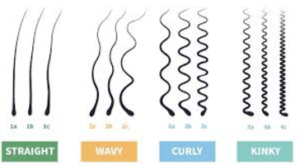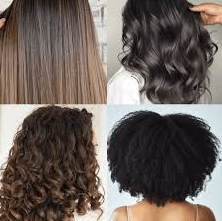Have you ever stood in the hair care aisle, completely overwhelmed by the countless products claiming to be perfect for your hair type, only to realize you’re not entirely sure what hair type you actually have? You’re not alone. Understanding what hair type you have is the foundation of developing an effective hair care routine that works specifically for your unique strands.
Your hair type influences everything from how you should wash and condition your locks to which styling techniques will give you the best results. It determines how your hair responds to humidity, how quickly it dries, and even which haircuts will be most flattering.
This comprehensive guide, will walk you through the different hair classification systems, help you accurately determine what hair type you have, and provide tailored care recommendations that will transform your relationship with your hair.

Understanding Hair Type Classifications
Before diving into identification methods, it’s helpful to understand the most widely accepted system for classifying hair types. The Andre Walker Hair Typing System, created by Oprah Winfrey’s former hairstylist, categorizes hair into four main types, with subcategories within each:
Type 1: Straight Hair
- Type 1A: Completely straight, fine, and often shiny hair that resists curling
- Type 1B: Straight with slight body and medium texture
- Type 1C: Straight but coarse and thick, may develop a slight bend
Type 2: Wavy Hair
- Type 2A: Fine, loose S-shaped waves with minimal frizz
- Type 2B: More defined S-waves starting from mid-length, medium texture
- Type 2C: Thick, coarse waves that begin at the roots, prone to frizz
Type 3: Curly Hair
- Type 3A: Loose, springy curls with clear S-pattern, circumference of a wine cork
- Type 3B: Tighter, springy curls with the circumference of a Sharpie marker
- Type 3C: Very tight corkscrews with the circumference of a pencil or straw
Type 4: Coily/Kinky Hair
- Type 4A: Tightly coiled S-pattern, springy texture with visible definition
- Type 4B: Tighter Z-pattern curls with less definition, more fluffy appearance
- Type 4C: Very tight Z-pattern with minimal definition, prone to shrinkage

Beyond the main type designations, several other characteristics influence your overall hair profile:
Hair Density
- Low Density: You can easily see your scalp through your hair
- Medium Density: You can see some scalp, but hair provides decent coverage
- High Density: Scalp is barely visible, hair appears full and thick
Hair Porosity
- Low Porosity: Cuticles are tightly closed, repels moisture, products sit on top
- Medium Porosity: Balanced moisture retention and absorbency
- High Porosity: Cuticles are very open, absorbs moisture quickly but loses it easily
Hair Thickness/Width
- Fine: Individual strands are thin and may break easily
- Medium: Average strand thickness
- Coarse: Individual strands are thick and strong
Understanding these characteristics alongside your primary hair type will give you a comprehensive picture of your hair’s needs.
How to Determine What Hair Type You Have
Now that you understand the classification system, let’s explore several methods to accurately identify your hair type:
The Wash and Wait Test
This simple test helps reveal your natural pattern:
- To get rid of product buildup, wash your hair with a clarifying shampoo.
- Gently towel-dry without rubbing, which can disrupt your natural pattern
- Allow your hair to air dry completely without touching or manipulating it
- Once dry, examine the pattern that has naturally formed
The Strand Test
To determine thickness and texture:
- Take a single clean, dry strand of hair between your fingers
- If you can barely feel it, you likely have fine hair
- If you can feel it but it’s still soft, you probably have medium hair
- If it feels thick and sturdy, you likely have coarse hair
Visual Clues for Different Hair Types
Type 1 Indicators:
- Hair dries quickly
- Difficult to hold curl from styling tools
- Gets oily quickly
- Usually rests flat against the head.
Type 2 Indicators:
- Hair forms an ‘S’ shape when wet or dry
- More volume at the roots than Type 1
- Tends to frizz in humidity
- Waves become more pronounced when scrunched while damp
Type 3 Indicators:
- Clear spiral or ringlet pattern
- Significant shrinkage when dry compared to wet length
- Prone to frizz and dryness
- Holds styles well but can be sensitive to humidity
Type 4 Indicators:
- Tight coils or zigzag pattern
- Very significant shrinkage (up to 75%)
- Typically very dry and absorbent
- Dense and spongy texture when dry

Caring for Different Hair Types
Now that you’ve answered ‘what hair type do I have?’, here are some tailored care recommendations:
Type 1: Straight Hair Care
- Washing: Use lightweight, volumizing shampoos that won’t weigh hair down
- Conditioning: Focus conditioner on ends only to prevent roots from becoming flat
- Styling: Use mousse or lightweight volumizing products
- Challenges: Combating flatness and oil buildup
- Best Products: Clarifying shampoos, dry shampoo, texturizing sprays
Type 2: Wavy Hair Care
- Washing: Sulfate-free shampoos that clean without stripping moisture
- Conditioning: Regular conditioning from mid-shaft to ends
- Styling: Curl-enhancing creams, sea salt sprays, light-hold gels
- Challenges: Maintaining wave definition without frizz
- Best Products: Anti-frizz serums, wave enhancers, lightweight oils
Type 3: Curly Hair Care
- Washing: Co-washing or low-poo methods with sulfate-free products
- Conditioning: Deep condition regularly, leave-in conditioners essential
- Styling: Curl creams, styling gels, curl activators
- Challenges: Maintaining moisture balance and definition
- Best Products: Leave-in conditioners, curl-defining products, natural oils
Type 4: Coily/Kinky Hair Care
- Washing: Gentle cleansers, co-washing, infrequent shampooing
- Conditioning: Heavy deep conditioning treatments weekly
- Styling: Butter-based products, thick creams, styling custards
- Challenges: Preventing dryness and breakage, reducing shrinkage
- Best Products: Heavy moisturizers, natural butters, protective styling products
Special Considerations for Mixed Hair Types
Many people’s heads have multiple hair types. You might have curlier hair at the nape of your neck and straighter strands around your face. This is completely normal and requires a customized approach:
- Identify your dominant hair type and base your routine around that
- Use targeted products for different sections as needed
- Consider using different styling techniques for different areas
- Always layer products the correct way; from the lightest to heaviest
Common Hair Type Transitions and Changes
Your hair type can change throughout your life due to various factors:
- Hormonal Changes:
Hormonal changes such as menopause and pregnancy can change the texture of hair.
- Aging:
Hair often becomes more coarse and less dense with age
- Chemical Treatments:
Perms, relaxers, and color treatments can temporarily or permanently change your natural pattern
- Health Conditions:
Certain medical conditions and medications can affect hair texture. If you’ve experienced changes in your hair type, give yourself time to reevaluate and adjust your routine accordingly.
Hairstyles That Work Best for Each Hair Type
Choosing hairstyles that work with your natural texture rather than against it will minimize damage and frustration:
Type 1: Straight Hair
- Blunt cuts to create the illusion of thickness
- Layers to add movement and volume
- Face-framing pieces to soften facial features
Type 2: Wavy Hair
- Long layers to enhance natural waves
- Shoulder-length cuts to allow waves to form properly
- Side-swept bangs that work with the natural texture
Type 3: Curly Hair
- Rounded layers to prevent triangle shape
- Longer lengths to help weigh down curls if desired
- DevaCut or other curl-specific cutting techniques
Type 4: Coily/Kinky Hair
- Tapered cuts to showcase natural texture
- Layered styles to manage volume
- Strategic shapes that work with, not against, natural shrinkage
FAQs
Can your hair type change over time?
Yes, your hair type can absolutely change throughout your life. Hormonal fluctuations during puberty, pregnancy, or menopause can alter your hair texture. Aging naturally changes hair structure, often making it coarser or thinner.
Medical conditions, medications, chemical processes, and even significant stress can temporarily or permanently shift your hair type. This is why it’s important to reassess your hair type periodically and adjust your hair care routine accordingly.
How can I determine if I have high or low porosity hair?
To test your hair’s porosity, take a clean strand of hair and drop it into a glass of water. If it floats for a long time, you likely have low porosity hair with tightly closed cuticles that repel water, if it sinks slowly, you probably have medium porosity, if it sinks immediately, you have high porosity hair with open cuticles that quickly absorb moisture.
Another method is the spray bottle test: spray water on dry hair and observe—if water beads up and sits on top, you have low porosity; if it absorbs quickly, you have high porosity.
Why does my hair look different when I travel to different climates?
Your hair responds dramatically to environmental factors like humidity, temperature, and water quality. In humid climates, hair typically swells and absorbs moisture from the air—making straight hair limp, wavy hair frizzier, and curly hair more voluminous.
In dry climates, hair loses moisture, which can make all hair types appear more lifeless or create different frizz patterns. Water mineral content varies by location as well; hard water can deposit minerals on hair, making it feel different than when washed with soft water.
Can using the wrong products change my natural hair type?
Using inappropriate products won’t permanently change your hair type, but they can significantly alter how your natural texture behaves and appears. Heavy products on fine hair can weigh it down, making naturally wavy hair appear straighter. Insufficient moisture for curly types can reduce definition and create frizz, making curls appear less organized.
While these effects are temporary and wash away, consistent use of unsuitable products can lead to buildup, damage, or altered texture that might make accurately identifying your true hair type difficult.
Can one head have more than one type of hair?
Yes, it’s extremely common to have multiple hair types on one head. Many people experience different textures in different areas—typically curlier at the nape of the neck and crown, and straighter around the face or temples.
This variation can be due to follicle shape differences across your scalp, hormonal influences, exposure to environmental factors, or even sleeping positions. This mixed pattern is completely normal and often requires a customized approach using different techniques or products for different sections of your hair.
Conclusion…
Understanding what hair type you have is the important first step in developing a hair care routine tailored to your particular requirements. By identifying where you fall on the spectrum of hair types and considering other important factors like density, porosity, and individual strand thickness, you can make informed decisions about products, styling techniques, and even haircuts.
Remember that your hair type isn’t a box that limits you, but rather a guide that helps you work more effectively with your natural texture. Embracing your natural hair type can lead to healthier hair, less damage from fighting your texture, and ultimately more good hair days.
Take time to experiment with the recommendations for your specific hair type, but don’t be afraid to customize based on what works best for your individual hair. Your perfect hair care routine is as unique as you are, and understanding your hair type is the key to unlocking its full potential.



